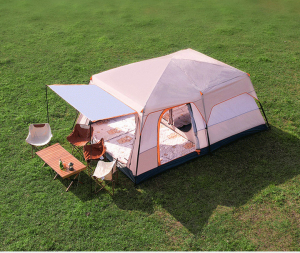News Center+ 查看更多
News Center
+ 查看更多
A Tale of Tents: The Canvas City That Travels With Us+ 查看更多
A Tale of Tents: The Canvas City That Travels With Us
+ 查看更多
Date:2024-04-08
The tent is more than a mere shelter; it is a canvas city that travels with us, a portable home that has housed humanity's quest for adventure across millennia. From the silk tents of Asian nomads to the high-tech nylon habitats of modern campers, the evolution of the tent is interwoven with our history, our technological progress, and our indefatigable spirit of exploration.
The Nomadic Nexus: Early Origins of the Tent
Our tale begins in the vast steppes of Central Asia, where the tent served as the primary dwelling for nomadic tribes. These early tents, or yurts, were constructed from animal skins and felted wools draped over wooden frames—a design born out of a need for mobility and resilience against harsh weather. The circular shape not only provided stability against the winds but also fostered a communal living space, central to the social structure of these communities.
Campaigns and Crusades: The Tent Goes to War
As empires expanded, the tent became an indispensable part of military campaigns. The Roman legions, for example, perfected the use of leather tents for their campaigns, establishing fortified camps known as castra. During the medieval era, grand pavilions were erected on battlefields serving as command posts that displayed power and prestige. The iconic imagery of King Henry VIII's Field of the Cloth of Gold exemplifies how tents were used as symbols of wealth and diplomacy.
The Age of Exploration: Tents on New Horizons
With the Age of Exploration, the tent was brought into new territories. Explorers like Marco Polo and later, pioneers traversing the American West, relied on their portability. Tents provided a sense of home amidst the unknown and often treacherous frontiers. As expeditions pushed into more extreme environments, the tent had to adapt, leading to innovations in materials and design.
Industrialization and Recreation: The Democratization of Camping
The Industrial Revolution introduced mass-produced cotton canvas, making tents more accessible. Coupled with the burgeoning idea of leisure and the romanticism of the wilderness in the 19th century, camping emerged as a pastime for the middle class. Organizations like the Boy Scouts helped popularize recreational camping, and the tent became a symbol of escape from the industrialized world.
An Iconic Example: The A-Frame Tent
A testament to this era's influence on tent design is the classic A-frame tent. Simple yet effective, its triangular silhouette became synonymous with camping from the mid-20th century onward. The A-frame represented a democratization of the outdoors, allowing families and individuals of varying means to forge connections with nature.
Technological Tents: Engineering the Future
The latter half of the 20th century saw synthetic materials like nylon and polyester transform tent manufacturing. These fabrics offered waterproofing, wind resistance, and a significant reduction in weight. Dome tents, geodesic designs, and pop-up tents leveraged these materials, fostering a new age of durability and convenience.
Innovating Shelter: The Nbalps GeoDome Series
Modern explorations have given rise to models like the Nbalps GeoDome series, which uses geodesic principles to maximize space and withstand severe conditions. Not only are these designs a marvel in structural innovation, but they also reflect our ongoing pursuit to harmonize comfort with the call of the wild.
Environmental Enclaves: Sustainable Shelters
Today, as we grow more conscious of our environmental footprint, the tent industry is pivoting towards sustainability. Eco-friendly materials, reduced waste production methods, and longer-lasting products represent this shift. Tents are no longer just temporary dwellings but statements of stewardship towards the lands they allow us to inhabit.
A Traveling Tradition
From ancient times to the present day, the story of the tent is rich with adaptation and imagination. It has been a companion to hunters, warriors, explorers, and vacationers—a witness to both survival and leisure. As we zip up our tents under starlit skies, we partake in a tradition that has endured through the ages, one that promises not just a place to rest, but a way to carry the essence of home wherever our hearts lead us.
In our canvas cities, we find solace and adventure, carrying forward the legacy of countless journeys and inviting tomorrow's explorers to unfold the tale of tents anew.

